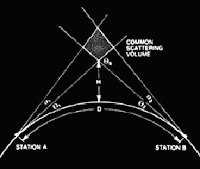 With all the nuance you can see why most of us just call it "Tropo." Really we're not sure which of the fascinating but very complex effects caused the distant reception. Hell, signals have been known to bounce off of airplanes and even formations of birds.
With all the nuance you can see why most of us just call it "Tropo." Really we're not sure which of the fascinating but very complex effects caused the distant reception. Hell, signals have been known to bounce off of airplanes and even formations of birds.In New Brunswick Canada, in the summer in the middle of the afternoon, in the middle of a montain pass I lost a local FM station to another in Norfolk. To this day, I am not certain which tropo effect caused it. It was a distance of slightly over 800 miles, so that tends to eliminate ducting but not for certain, it eliminates scatter but not reflection and defnintely includes E-skip as a possibility. But it might also have been a weird pirate or a very fat bird.

Tropospheric Refraction - "The standard atmosphere is defined as air at sea level having a temperature of 59° F, a barometric pressure of 29.92 inches of mercury, and a density of 0.002378 slugs per cubic foot. As we increase altitude within our standard atmosphere, the temperature, pressure and density decrease at fixed rates."http://www.mike-willis.com/Tutorial/refraction.htm

When a wave enters a new medium at an angle of less than 90°, the change in speed occurs sooner on one side of the wave than on the other, causing the wave to bend. This downwards bending can compensate approximate the curve of the earth. the end result being that the radio wave can propagate beyond line of sight. It's easier to imagine when you compare it to the visual effect of a staw in water. that distortion you see is light refraction; a similar effect.
Tropospheric Scatter - Tropospheric scatter is the most common form of tropospheric effect on radio wave propagation. Tropo-scatter is always present (to a varied degree) on all broadcast radio waves. Tropospheric scatter at FM and TV frequencies is caused when the paths of radio signals are altered by slight changes in the refractive index in the lower atmosphere.
This can be caused by air turbulence, and minor temperature changes, even humidity and barometric pressure variations. The signal is scattered in random fashion. The tiny portion of the transmitted signal that is scattered forward and downward from what is called the "common scattering volume" is responsible for signal paths longer than the normal line-of-sight horizon.
Thats of course different from the other scatter, Meteor Scatter - This results from radio signals bouncing off of the intensely ionized trails of meteors entering and burning up from air friction in the E region of the ionosphere. Meteor scatter can be heard anywhere, anytime of the day or night entirely dependant on the number of masteroids in our neighborhood.




No comments:
Post a Comment